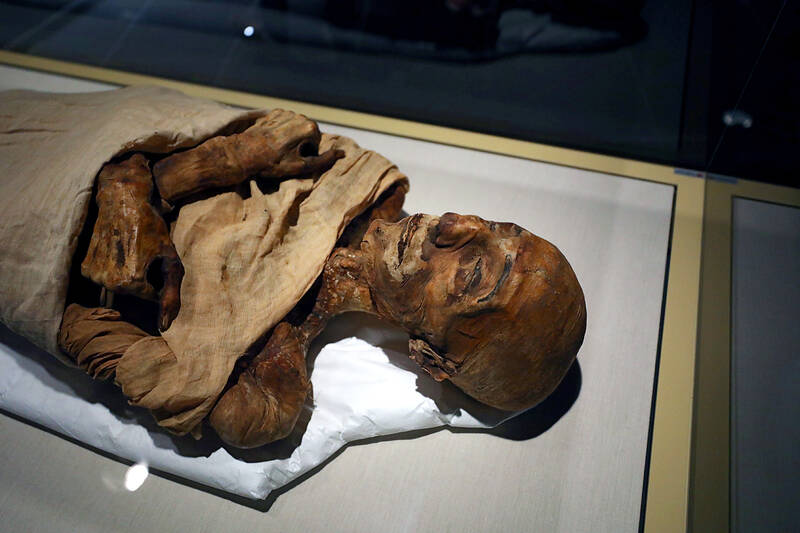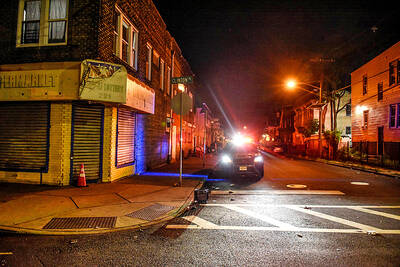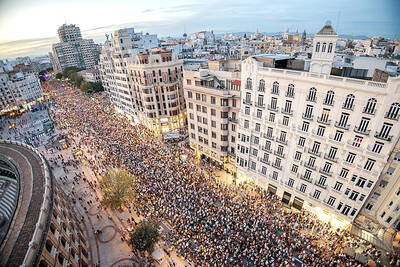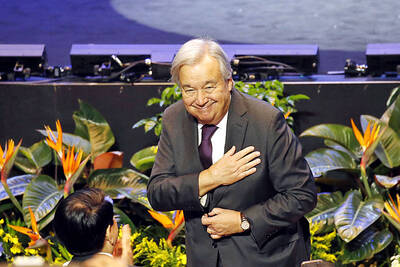At first whiff, it sounds repulsive: Sniff the essence of an ancient corpse.
However, researchers who indulged their curiosity in the name of science found that well-preserved Egyptian mummies actually smell pretty good.
“In films and books, terrible things happen to those who smell mummified bodies,” University College London’s (UCL) Institute for Sustainable Heritage research director Cecilia Bembibre said. “We were surprised at the pleasantness of them.”

Photo: EPA-EFE
“Woody,” “spicy” and “sweet” were the leading descriptions from what sounded more like a wine tasting than a mummy sniffing exercise. Floral notes were also detected, which could be from pine and juniper resins used in embalming.
The study published on Thursday in the Journal of the American Chemical Society used chemical analysis and a panel of human sniffers to evaluate the odors from nine mummies as old as 5,000 years that had been either in storage or on display at the Egyptian Museum in Cairo.
The researchers wanted to systematically study the smell of mummies, because it has long been a subject of fascination for the public and researchers alike, said Bembibre, one of the report’s authors.
Archeologists, historians, conservators and even fiction writers have devoted pages of their work to the subject — for good reason.
Scent was an important consideration in the mummification process that used oils, waxes and balms to preserve the body and its spirit for the afterlife. The practice was largely reserved for pharaohs and nobility and pleasant smells were associated with purity and deities while bad odors were signs of corruption and decay.
Without sampling the mummies themselves, which would be invasive, researchers from UCL and the University of Ljubljana were able to measure whether aromas were coming from the archaeological item, pesticides or other products used to conserve the remains, or from deterioration due to mold, bacteria or microorganisms.
“We were quite worried that we might find notes or hints of decaying bodies, which wasn’t the case,” University of Ljubljana chemistry professor Matija Strlic said. “We were specifically worried that there might be indications of microbial degradation, but that was not the case, which means that the environment in this museum, is actually quite good in terms of preservation.”
Using technical instruments to measure and quantify air molecules emitted from sarcophagi to determine the state of preservation without touching the mummies was like the Holy Grail, Strlic said.
“It tells us potentially what social class a mummy was from and therefore reveals a lot of information about the mummified body that is relevant not just to conservators, but to curators and archeologists as well,” he said. “We believe that this approach is potentially of huge interest to other types of museum collections.”
Barbara Huber, a postdoctoral researcher at Max Planck Institute of Geoanthropology in Germany who was not involved in the study, said the findings provide crucial data on compounds that could preserve or degrade mummified remains.
The information could be used to better protect the ancient bodies for future generations, Huber said.
“However, the research also underscores a key challenge: The smells detected today are not necessarily those from the time of mummification,” Huber said. “Over thousands of years, evaporation, oxidation, and even storage conditions have significantly altered the original scent profile.”
Huber authored a study two years ago that analyzed residue from a jar that had contained mummified organs of a noblewoman to identify embalming ingredients, their origins and what they revealed about trade routes. She then worked with a perfumer to create an interpretation of the embalming scent, known as “Scent of Eternity,” for an exhibition at the Moesgaard Museum in Denmark.
Researchers of the current study hope to do something similar, using their findings to develop “smellscapes” to artificially recreate the scents they detected and enhance the experience for future museumgoers.
“Museums have been called white cubes, where you are prompted to read, to see, to approach everything from a distance with your eyes,” Bembibre said. “Observing the mummified bodies through a glass case reduces the experience because we don’t get to smell them. We don’t get to know about the mummification process in an experiential way, which is one of the ways that we understand and engage with the world.”

DOUBLE-MURDER CASE: The officer told the dispatcher he would check the locations of the callers, but instead headed to a pizzeria, remaining there for about an hour A New Jersey officer has been charged with misconduct after prosecutors said he did not quickly respond to and properly investigate reports of a shooting that turned out to be a double murder, instead allegedly stopping at an ATM and pizzeria. Franklin Township Police Sergeant Kevin Bollaro was the on-duty officer on the evening of Aug. 1, when police received 911 calls reporting gunshots and screaming in Pittstown, about 96km from Manhattan in central New Jersey, Hunterdon County Prosecutor Renee Robeson’s office said. However, rather than responding immediately, prosecutors said GPS data and surveillance video showed Bollaro drove about 3km

Tens of thousands of people on Saturday took to the streets of Spain’s eastern city of Valencia to mark the first anniversary of floods that killed 229 people and to denounce the handling of the disaster. Demonstrators, many carrying photos of the victims, called on regional government head Carlos Mazon to resign over what they said was the slow response to one of Europe’s deadliest natural disasters in decades. “People are still really angry,” said Rosa Cerros, a 42-year-old government worker who took part with her husband and two young daughters. “Why weren’t people evacuated? Its incomprehensible,” she said. Mazon’s

‘MOTHER’ OF THAILAND: In her glamorous heyday in the 1960s, former Thai queen Sirikit mingled with US presidents and superstars such as Elvis Presley The year-long funeral ceremony of former Thai queen Sirikit started yesterday, with grieving royalists set to salute the procession bringing her body to lie in state at Bangkok’s Grand Palace. Members of the royal family are venerated in Thailand, treated by many as semi-divine figures, and lavished with glowing media coverage and gold-adorned portraits hanging in public spaces and private homes nationwide. Sirikit, the mother of Thai King Vajiralongkorn and widow of the nation’s longest-reigning monarch, died late on Friday at the age of 93. Black-and-white tributes to the royal matriarch are being beamed onto towering digital advertizing billboards, on

POWER ABUSE WORRY: Some people warned that the broad language of the treaty could lead to overreach by authorities and enable the repression of government critics Countries signed their first UN treaty targeting cybercrime in Hanoi yesterday, despite opposition from an unlikely band of tech companies and rights groups warning of expanded state surveillance. The new global legal framework aims to bolster international cooperation to fight digital crimes, from child pornography to transnational cyberscams and money laundering. More than 60 countries signed the declaration, which means it would go into force once ratified by those states. UN Secretary-General Antonio Guterres described the signing as an “important milestone,” and that it was “only the beginning.” “Every day, sophisticated scams destroy families, steal migrants and drain billions of dollars from our economy...